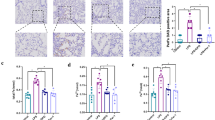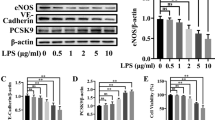Abstract
Rationale
Pulmonary hypertension (PH) represents a serious health complication accompanied with hypoxic conditions, elevated levels of asymmetric dimethylarginine (ADMA), and overall dysfunction of pulmonary vascular endothelium. Since the prevention strategies for treatment of PH remain largely unknown, our study aimed to explore the effect of nitro-oleic acid (OA-NO2), an exemplary nitro-fatty acid (NO2-FA), in human pulmonary artery endothelial cells (HPAEC) under the influence of hypoxia or ADMA.
Methods
HPAEC were treated with OA-NO2 in the absence or presence of hypoxia and ADMA. The production of nitric oxide (NO) and interleukin-6 (IL-6) was monitored using the Griess method and ELISA, respectively. The expression or activation of different proteins (signal transducer and activator of transcription 3, STAT3; hypoxia inducible factor 1α, HIF-1α; endothelial nitric oxide synthase, eNOS; intercellular adhesion molecule-1, ICAM-1) was assessed by the Western blot technique.
Results
We discovered that OA-NO2 prevents development of endothelial dysfunction induced by either hypoxia or ADMA. OA-NO2 preserves normal cellular functions in HPAEC by increasing NO production and eNOS expression. Additionally, OA-NO2 inhibits IL-6 production as well as ICAM-1 expression, elevated by hypoxia and ADMA. Importantly, the effect of OA-NO2 is accompanied by prevention of STAT3 activation and HIF-1α stabilization.
Conclusion
In summary, OA-NO2 eliminates the manifestation of hypoxia- and ADMA-mediated endothelial dysfunction in HPAEC via the STAT3/HIF-1α cascade. Importantly, our study is bringing a new perspective on molecular mechanisms of NO2-FAs action in pulmonary endothelial dysfunction, which represents a causal link in progression of PH.

ᅟ




Similar content being viewed by others
References
Sitbon O, Lascoux-Combe C, Delfraissy JF, et al. Prevalence of HIV-related pulmonary arterial hypertension in the current antiretroviral therapy era. Am J Resp Crit Care. 2008;177:108–13.
Schermuly RT, Ghofrani HA, Wilkins MR, Grimminger F. Mechanisms of disease: pulmonary arterial hypertension. Nat Rev Cardiol. 2011;8:443–55.
Fonseca GH, Souza R, Salemi VM, Jardim CV, Gualandro SF. Pulmonary hypertension diagnosed by right heart catheterization in sickle cell disease. Eur Respir J. 2012;39:112–8.
Sanli C, Oguz D, Olgunturk R, et al. Elevated homocysteine and asymmetric dimethyl arginine levels in pulmonary hypertension associated with congenital heart disease. Pediatr Cardiol. 2012;33:1323–31.
Lüneburg N, Harbaum L, Hennigs JK. The endothelial ADMA/NO pathway in hypoxia-related chronic respiratory diseases. Biomed Res Int. 2014.
Parikh RV, Scherzer R, Nitta EM, et al. Increased levels of asymmetric dimethylarginine are associated with pulmonary arterial hypertension in HIV infection. AIDS. 2014;28:511–9.
Trittmann JK, Peterson E, Rogers LK, et al. Plasma asymmetric dimethylarginine levels are increased in neonates with bronchopulmonary dysplasia-associated pulmonary hypertension. J Pediatr. 2015;166:230–3.
Iannone L, Zhao L, Dubois O, et al. miR-21/DDAH1 pathway regulates pulmonary vascular responses to hypoxia. Biochem J. 2014;462:103–12.
Pekarova M, Koudelka A, Kolarova H, et al. Asymmetric dimethyl arginine induces pulmonary vascular dysfunction via activation of signal transducer and activator of transcription 3 and stabilization of hypoxia-inducible factor 1-alpha. Vasc Pharmacol. 2015;73:138–48.
Rudolph TK, Rudolph V, Edreira MM, et al. Nitro-fatty acids reduce atherosclerosis in apolipoprotein E-deficient mice. Arterioscl Throm Vas. 2010;30:938–45.
Rudolph V, Rudolph TK, Schopfer FJ, et al. Endogenous generation and protective effects of nitro-fatty acids in a murine model of focal cardiac ischaemia and reperfusion. Cardiovasc Res. 2010;85:155–66.
Khoo NK, Rudolph V, Cole MP, et al. Activation of vascular endothelial nitric oxide synthase and heme oxygenase-1 expression by electrophilic nitro-fatty acids. Free Radic Biol Med. 2010;48:230–9.
Zhang J, Villacorta L, Chang L, et al. Nitro-oleic acid inhibits angiotensin II–induced hypertension. Circ Res. 2010;107:540–8.
Kansanen E, Jyrkkänen HK, Volger OL, et al. Nrf2-dependent and -independent responses to nitro-fatty acids in human endothelial cells: identification of heat shock response as the major pathway activated by nitro-oleic acid. J Biol Chem. 2009;284:33233–41.
Schopfer FJ, Cole MP, Groeger AL, et al. Covalent peroxisome proliferator-activated receptor{gamma} binding by nitro-fatty acids: endogenous ligands act as selective modulators. J Biol Chem. 2010;285:12321–33.
Klinke A, Möller A, Pekarova M, et al. Protective effects of 10-nitro-oleic acid in a hypoxia-induced murine model of pulmonary hypertension. Am J Resp Cell Mol. 2014;51:155–62.
Yang XP, Irani K, Mattagajasingh S, et al. Signal transducer and activator of transcription 3alpha and specificity protein 1 interact to upregulate intercellular adhesion molecule-1 in ischemic-reperfused myocardium and vascular endothelium. Arterioscl Throm Vasc. 2005;25:1395–400.
Paulin R, Meloche J, Bonnet S. STAT3 signaling in pulmonary arterial hypertension. JAK-STAT. 2012;1:223–33.
Sun CK, Zhen YY, Lu HI, Sung PH, et al. Reducing TRPC1 expression through liposome-mediated siRNA delivery markedly attenuates hypoxia-induced pulmonary arterial hypertension in a murine model. Stem Cells Int. 2014;2014:316214.
Ambrozova G, Martiskova H, Koudelka A, et al. Nitro-oleic acid modulates classical and regulatory activation of macrophages and their involvement in pro-fibrotic responses. Free radical bio med. 2016; 90:252-60.Lim DG, Sweeney S, Bloodsworth a, et al. Nitrolinoleate, a nitric oxide-derived mediator of cell function: synthesis, characterization, and vasomotor activity. P Natl Acad Sci USA. 2002;99:15941–6.
Lima ES, Bonini MG, Augusto O, Barbeiro HV, Souza HP, Abdalla DS. Nitrated lipids decompose to nitric oxide and lipid radicals and cause vasorelaxation. Free Radic Biol Med. 2005;39:532–9.
Freeman BA, Baker PR, Schopfer FJ, Woodcock SR, Napolitano A, d’Ischia M. Nitro-fatty acid formation and signaling. J Biol Chem. 2008;283:15515–9.
Shin E, Yeo E, Lim J, et al. Nitrooleate mediates nitric oxide synthase activation in endothelial cells. Lipids. 2014;49:457–66.
Wang H, Jia Z, Sun J, et al. Nitrooleic acid protects against cisplatin nephropathy: role of COX-2/mPGES-1/PGE2 cascade. Mediat Inflamm 2015.
Balazy M, Iesaki T, Park JL, et al. Vicinal nitrohydroxyeicosatrienoic acids: vasodilator lipids formed by reaction of nitrogen dioxide with arachidonic acid. J Pharmacol Exp Ther. 2001;299:611–9.
Schopfer FJ, Baker PR, Giles G, et al. Fatty acid transduction of nitric oxide signaling. Nitrolinoleic acid is a hydrophobically stabilized nitric oxide donor. J Biol Chem. 2005;280:19289–97.
Ambrozova G, Fidlerova T, Verescakova H, et al. Nitro-oleic acid inhibits vascular endothelial inflammatory responses and the endothelial-mesenchymal transition. Biochim Biophys Acta. 2016; pii: S0304–4165(16)30251–30253.
Reddy AT, Lakshmi SP, Dornadula S, Pinni S, Rampa DR, Reddy RC. The nitrated fatty acid 10-nitro-oleate attenuates allergic airway disease. J Immunol. 2013;191:2053–63.
Villacorta L, Chang L, Salvatore SR, et al. Electrophilic nitro-fatty acids inhibit vascular inflammation by disrupting LPS-dependent TLR4 signalling in lipid rafts. Cardiovasc Res. 2013;98:116–24.
Wu Y, Dong Y, Song P, Zou MH. Activation of the AMP-activated protein kinase (AMPK) by nitrated lipids in endothelial cells. PLoS One. 2012.
Stenmark KR, Fagan KA, Frid MG. Hypoxia-induced pulmonary vascular remodeling: cellular and molecular mechanisms. Circ Res. 2006;99:675–91.
Rudnicki M, Faine LA, Dehne N, et al. Hypoxia inducible factor-dependent regulation of angiogenesis by nitro-fatty acids. Arterioscl Throm Vasc. 2011;31:1360–7.
Saura M, Zaragoza C, Bao C, Herranz B, Rodriguez-Puyol M, Lowenstein CJ. Stat3 mediates interleukin-6 [correction of interelukin-6] inhibition of human endothelial nitric-oxide synthase expression. J Biol Chem. 2006;281:30057–62.
Acknowledgments
We would like to thank Jirina Prochazkova, Lenka Svihalkova Sindlerova, and Ondrej Vasicek for a fruitful discussion and insightful suggestions.
Author information
Authors and Affiliations
Corresponding author
Ethics declarations
Funding
This work was supported by the Czech Science Foundation (no. 13-40824P), the Ministry of Education, Youth and Sports (no. LD15069). LK and MP were supported by the European Regional Development Fund, the projects NPS II no. LQ1605 and FNUSA-ICRC no. CZ.1.05/1.1.00/02.0123 from MEYS CR. BAF was supported by NIH grants R01-HL-058115, R01-HL-64937, and PO1-HL-103455.
Conflict of Interest
Bruce A. Freeman (BAF) and Steven R. Woodcock (SRW) acknowledge an interest in Complexa, Inc., as scientific founder/shareholder (BAF) and consultant (SRW). All other authors declare no conflicts of interest with respect to the contents of this manuscript.
Ethical Approval
This article does not contain any studies with human participants or animals performed by any of the authors.
Electronic Supplementary Material
ESM 1
(DOCX 1.30 mb)
Rights and permissions
About this article
Cite this article
Koudelka, A., Ambrozova, G., Klinke, A. et al. Nitro-Oleic Acid Prevents Hypoxia- and Asymmetric Dimethylarginine-Induced Pulmonary Endothelial Dysfunction. Cardiovasc Drugs Ther 30, 579–586 (2016). https://doi.org/10.1007/s10557-016-6700-3
Published:
Issue Date:
DOI: https://doi.org/10.1007/s10557-016-6700-3




